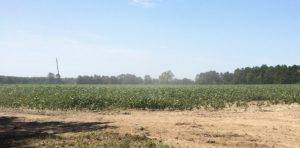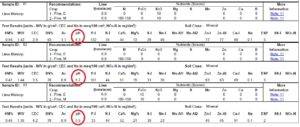Establishing Longleaf pines (LLP) on old agricultural fields is particularly challenging due to aggressive weed species and high soil fertility. Careful site preparation is important for success. The last commercial crop of cotton was planted in our 20.8 acre field in the summer of 2015.  A Fall cover crop of winter wheat followed. Prior to these plantings the farmer reviewed his plans with the county forester to avoid herbicides that would interfere with our tree planting in Fall/Winter 2016. He was also instructed to avoid adding lime to the fields (target soil pH <6, more acidic, for successful tree planting).
A Fall cover crop of winter wheat followed. Prior to these plantings the farmer reviewed his plans with the county forester to avoid herbicides that would interfere with our tree planting in Fall/Winter 2016. He was also instructed to avoid adding lime to the fields (target soil pH <6, more acidic, for successful tree planting).
After the wheat, we left the field go fallow for the Summer and Fall.  To assure our soil was in the correct ph range for planting, we sent multiple soil samples to the state lab in mid-Summer. In early July we ordered container grown improved LLP seedlings from the NC Forest Service Nursery and reserved for pick-up in late Fall for planting.
To assure our soil was in the correct ph range for planting, we sent multiple soil samples to the state lab in mid-Summer. In early July we ordered container grown improved LLP seedlings from the NC Forest Service Nursery and reserved for pick-up in late Fall for planting.
To suppress weed competition the next step was pre-planting herbicide spraying in late summer of 2016. Our management plan included a specific chemical recipe. Although we like to do much of the work on our own, a certified contractor did the spraying for us. Twenty acres were too much for our equipment and we lacked the expertise for handling these herbicides.
The last step before planting was a controlled burn. We received multiple benefits from this.
- Burning helps to kill off any potential remaining weeds missed during the herbicide treatment.
- Burning decreases crop residue (stems, sticks, leaves, etc.) making it easier for tree planting.
- Burning of crop residue releases minerals into the soil that are then available for new plant (tree) growth.
- Jeanette and I used this opportunity to finish the last certification step in our state Certified Burners process.
We completed the burning in late November of 2016. Thank you to the members of the Sandhills Prescribed Burn Association (PBA) for their help.
Finally, we could get on with the planting!
Next: Planting
